| If this newsletter does not display correctly, please click here. |
 |
| |
Dear friends,
Like a blurr, another Argentina and Chile fishing season has come to an end. It went out with an absolute bang. Many big fish were caught during the last weeks, closing the season as fantastically as it started. In this Newsletter you will find the highlights at each of our lodges written by the main characters, our international team of fishing managers. |
 |
| The Nervous Waters Team |
| |
|
 |
|
|
| |
|
|
| REPORT FROM THE RIO GRANDE |
| Kau Tapen and Villa Maria Lodge |
 |
The season at Rio Grande started atypically early and produced great number of fish from beginning to end. It was an epic year. The biggest fish landed weighted 31 pounds! + info |
 |
|
|
| FUTA LODGE CLOSES ANOTHER SEASON |
| Futaleufu, Patagonia |
 |
We enjoyed great weather this year in Patagonia (only a few days of hard rain), and the river was very low and clear, around 10,000 cfs. All of our floats produced numerous fish. + info |
 |
|
 |
|
 |
| |
|
| DORADO END OF SEASON REPORT |
| Pirá Lodge |
 |
In my mind I keep the memories of one of the best seasons at Pirá. We worked hard to provide guests a time to remember. The fishing helped matters with an average of 10 fish per day per person. + info |
 |
|
|
BAHAMAS SEASON IN FULL SWING
|
| Bair's and Abaco Lodge |
 |
Our two Bahamas lodges also have plenty to tell us about how their seasons went, not only in terms of fishing but also island news and lodge upgrades.+ info |
 |
|
|
|
| |
|
|
|
|
 |
 |
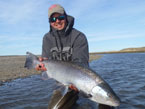 |
 |
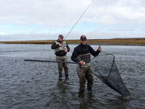 |
 |
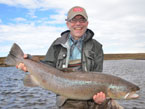 |
 |
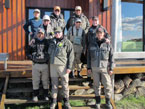 |
 |
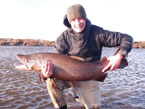 |
| 31 pounds monster trout landed by Max |
 |
 |
|
|
| |
| RIO GRANDE END OF SEASON REPORTS |
| |
| Kau Tapen Report |
| |
| By the Numbers: |
| |
| |
1,348—Fish caught and landed out of 1,724 fish hooked |
|
| |
1.66—Average # of fish caught per rod, per day |
|
| |
8.29 pounds—Average weight |
|
| |
31 pounds—Biggest fish |
|
| |
128—Fish over 15 pounds, and 51 fish over 20 pounds |
|
|
| |
Kau Tapen's 2012 season saw an incredible team of international and local Argentinean guides. International guides included lodge veterans Max, Pelle, Matthew, and myself. We are always happy to come back to the Rio Grande for another season—to shake hands with old friends and to hook exceptional fish on the best sea trout river in the world!
We started the season with atypical weather in January. The water was low and clear, which made for great fishing with light lines and tips. Instead of big, heavy full-sinking lines and gangly leeches, we fished floaters and slow to fast sink tips, as well as small flies—one of my favorite ways to catch these monster fish.
Returning fish numbers were strong and we noticed several changes in the river's course formed by a powerful spring run-off. Some pools changed shape and got shallower, and we found new pools that turned out to be productive all season long: "Youngie", "Russo", and "Happy Hour" to name a few…. The changes were welcomed. On the other hand, all the guides knew we needed rain to maintain or raise the water level. The rain didn't come, at least not much, and the river kept dropping, with clearer and cooler conditions. We fished long, thin leaders with smaller nymphs and streamers. What sport! And it produced! Although, we experienced tough days getting everything dialed in: the right fly for the right speed, depth, light, and mood of the fish. Constantly altering our techniques and presentations was key. We had great days as well, with more than 35 fish, and guests with 4 to 8 fish for the day.
Overall, the fishing was more challenging, interesting, and entertaining. We quickly found new hot spots. Some pools were good, holding a lot of fish at certain times during the season, while others were not as good. It's always a game of finding out where the "money holes" might be.
As far as the fishing, the catching was good… all season long—11 weeks with more than 100 fish. The fish numbers were more spread out than in previous years, when the best catches have occurred in late January to the end of Feb. March was a great month, while February was much colder than usual with dropping temperatures and tougher days. April was also very good, with big fish on the take all month.
This year at Kau Tapen we hooked and landed many fish exceeding 20 pounds, with one fish over 30 pounds and one 29 pounder. The river is producing a lot of double-digit fish and we were surprised to see how they managed to go upriver in such low water. We learned new things about sea trout techniques and created new flies—smaller in general to compensate for the crystal clear, low water. It was a great challenge that our guests delighted in it. Generally it was amazing to see how this river can produce good fishing despite adverse conditions. While other rivers in Tierra del Fuego and Southern Patagonia had tough times, the Rio Grande proved once again that it is the best sea trout river in the world. Many guests hooked and landed a fish of lifetime in 2012, with the Rio Grande at Kau Tapen and Villa Maria lodges setting the standard for trophy trout fishing in the region.
This year we welcomed repeat guests and also saw new faces from around the world. And are proud to see that Nervous Waters' lodges are coveted by keen fishers in search of luxurious accommodation, fine cuisine, great service and staff, and professional guides. Kau Tapen epitomizes all of this.
Lastly, thanks to all our Kau Tapen guests for sharing in another remarkable year. We're looking forward to seeing you next season.
Have a great 2012, and tight lines. |
| |
Jean Baptiste Vidal
|
| Kau Tapen Lodge |
| |
| Find out more about Kau Tapen Lodge. |
| |
| Villa Maria Report |
| |
I'm writing this, my final report for the season, as I look out of the window of a jet bound for Bozeman, Montana, and home. It's cliché, but time really does move faster when you are engaged in something you love. It was only a short time ago that I first looked out over the Rio Grande and wondered what the season held in store.
The Rio Grande and Villa Maria in particular are unique, world-class destinations by all measures. Over the course of the season, l shared time with anglers from around the world who have pursued sea trout from Iceland and Sweden to Wales and Ireland. When asked to compare them, they put the Rio Grande on the top of their lists. It's that good, and I'm fortunate to have had the chance to see these amazing fish for myself.
I feel doubly blessed to have finished the season with such a fantastic group of fellow guides and lodge staff. Anyone who's spent time with these folks will attest to the professionalism and dedication exhibited at the lodge and on the river. Thank you all for your hard work.
From the start we knew it wasn't going to be just another season. Water levels were low and many of the well-known pools had been altered by spring runoff, sometimes beyond recognition. Little did we know, the same conditions that caused us early trepidation would eventually contribute to one of the best seasons on record. The numbers speak for themselves: 362 fish over 15 pounds and 151 over 20 pounds, our season was stellar.
But when you really think about it, this is why anglers keep returning to the Rio Grande. Hunting and fishing is in our DNA, we are hardwired to participate in this dance between predator and prey. This is affirmed every time I look into the face of someone with their first living creature on the other end of the line. I don't care if you're 7 or 70, it's always the same. It is this joy at the surprise of the encounter, the not knowing what will happen next, that continually pulls us back to the river.
This, in my mind, explains the draw of this place at the end of the earth. There are few places on the planet that consistently provide the kind of surprises the Rio Grande delivers. You never know, when you raise your rod tip and set up, what will happen next. It could be anything from one of the small but gorgeous resident browns and rainbows or the next-record breaking sea runner that takes you deep into the backing and far downriver.
I, and everyone else at Villa Maria, have enjoyed sharing this season with all our new and returning guests. I hope this coming season finds us all back on the banks of the Rio Grande, patiently waiting to see what it holds in store. |
| |
Sean Blaine
|
| Fishing Manager, Villa Maria Lodge |
| |
| Find out more about Villa Maria Lodge. |
| |
 |
|
|
 |
 |
 |
|
|
| |
| FUTALEUFU END OF SEASON REPORT |
| |
The month of April means another season at the Futa Lodge is in the books. We enjoyed great weather this year in Patagonia (only a few days of hard rain), and the river was low and clear, around 10,000 cfs. All of our floats produced numerous fish. The top locations were the Limite float near the boarder of Argentina and Macal, which marks the lowest section of the Futa. I also had amazing days in the Poson de los Reyes—a giant eddy at the base of a box canyon, where we put in and take out in the same place for a full day (sounds like limited fishing opportunities, but that is not the case). The Poson is a 4-acre pool loaded with dry-fly fishing for picky rainbows. This location can be technical, but for an accomplished fisherman it's a sight casters dream!
Brian Hunt from California caught the biggest rainbow of the year on the last day of the season with guide Royce Olney. It went 26 inches and weighed 7 pounds. Great teamwork guys! The biggest brown was a toss up (lots of big browns this year). The one that stands out was a 6-pounder caught by Rene from Switzerland. Or the 6-pounder Lord Dillington from the U.K. caught on a dry fly. Beautiful colors and nice kype jaw!
One thing about the Futa is the unforgettable scenery and there is no better place to enjoy it than at the lodge. After a day on the water we always came home to great hors d'oeuvres served with the drink of choice next to the fire, or outside near the lounge patio.
Our staff this year included Carlos, Maria, and Antonella taking care of the casa; Royce and myself manning the oars; and my lovely wife Mary hosting. We enjoyed company from various parts of Europe and North America and Argentina. Maria had well prepared homemade lunches for our riverside picnics and amazing meals after a long day of fishing. The traditional asado was a hit every week, too... good job Carlos.
All in all it was a season to remember, and despite the airport closure in Esquel we all enjoyed great fishing and spectacular times at the Futa Lodge. Hope to see everybody again soon. |
|
| |
Brian McKnight
Manager
|
| |
| Click here to read more about Futa Lodge. |
| |
 |
|
|
 |
" border="0" cellspacing="0" cellpadding="0">
 |
|
|
 |
| IBERA MARSHED END OF SEASON REPORT |
| |
During the last two weeks, fall never showed up at this latitude. The weather was hot and the other missing guest to the party was rain, which made for low water levels. In my experience at Pirá, I've never seen it so low. It was going to be a challenge for the boats, motors, and guides. But let me say that these Hell's Bay boats can run on a wet floor. And that's exactly what it was like. We fished the headwaters of the river, mainly the North Channel. The fish were stacked and fishing was great—even for beginners. We also fished the small creeks that flow to the south channel and join together at Tito's fork. These creeks, wide as a table, were full of fish running up and down, spooked by our presence. Fishing was technical and required accurate shots and perfect presentations.
The end of the season was coming and we had more than six groups in two weeks. Busy. We were also running short on water, but a miraculous storm showed up and added inches to our thirsty marsh. Between the client groups, some families arrived with children and, due to exceptional fishing conditions, a small 8-year-old girl caught her first dorado.
Technically speaking, we used only floating lines. And the famous "Strip fast!" was replaced by the "Let it swing!" The average size dorado for the last month was 5 pounds. We had some 9, 10, and 13 pounders. Thankfully, the piranhas were M.I.A.
So the days become weeks, then months, and the season comes to an end. In my mind I keep memories of one of the best seasons at Pirá. We worked hard to provide guests a time to remember. The fishing helped matters with an average of 10 fish per day per person. The biggest fish was a 14 pounder, and we caught hundreds of 7s, 8s, and 9s. Fishing these dorado with a 6- or 7-weight rod is something you must do. Although they are not "runners," they jump like monkeys and pull like bulls. They don't give up easy, hook sets can be difficult, and the fishing is always great fun.
The early season allowed us to explore new places we hadn't ever fished. We found a mythical system of channels called "Ombucito" (Om-booh-see-toe). I dare to say that this place is our "el Dorado." The first time there we caught a 13 pounder. The fishing can be technical because the creeks are full of weeds. If you don't stop the fish, there's a good chance of losing it in the salad. The water is clear and requires longer leaders and smooth presentations to avoid spooking fish. It is a shallow area and with low-water conditions it is closed.
Peak season found us fishing the Corrientes River. The fishing was excellent with happy faces found daily at the bar. As I said many times we were running into drought conditions. That meant less places to fish, and fish crammed in the same areas like people in a subway at rush hour. Good for anglers, as well as guides.
In addition to the fishing the marsh was in great shape, with endless purple carpets of hyacinths, capybaras, and Caymans everywhere. During sunset the sky came alive with flocks of Jabirus, Roseate spoonbills, and ducks. Pirá is a bird paradise, with hundreds of species calling it home.
By season's end we started fishing what we call the Headwaters of the River. With low water, two main channels flowing from the marsh join to create the Corrientes. Fishing in those channels is always great, and this season was no exception: sessions of 20+ fish, with more than a half dozen larger than 8 pounds. A "great finale" for one of the best seasons ever.
After seven seasons at Iberá marsh, I've learned that every year is nuanced and different. Maybe the conditions are similar, but the fishing changes—and that's what makes dorado fishing at Pirá lodge so unique.
Hasta la vista… |
| |
Tito Saenz Rozas
Pira Lodge Fishing Manager |
| |
| For more information about Pira lodge, click here. |
| |
 |
|
|
 |
 |
|
|
 |
BAHAMAS MID-SEASON REPORT
|
|
Our two Bahamas lodges also have plenty to tell us about how their seasons went, not only in terms of fishing but also island news and lodge upgrades. |
| |
| Bair's Lodge |
| |
It's been an interesting year at Bair's in South Andros so far. In January, the bridge between the lodge and our services on the north end of the island was closed for repair for eight weeks. But we were able to keep the guests and provisions coming via ferry. About half of our staff live on the north side of the creek. The bridge is now open and we are relieved.
The lodge has received recent upgrades and we've have replaced three of our older boat motors with new 50hp Mercurys. We've gotten a completely new Reverse Osmosis Water System and we are now making the best water ever. We have replaced our stove with a new commercial propane unit that really heats up the joint (…and the food as well).
February fishing was probably the best in recent history. We were blessed with low winds and clear skies. March was a little windier than average, but we still had plenty of good fishing days. Ken Dial and Brian Sippy from Missoula, Montana, experienced a record-setting day in March. They reeled in over 100 pounds of bonefish, with at least a dozen over 5 pounds. Everything went right! April has been typical in terms of fishing. Very good! There have been a couple high-wind days, but for the most part they've been moderate and coupled with bright skies—perfect for sighting cruising bones on deeper flats.
We look forward to May, when we'll see many friends returning to Bair's for some of the best fishing South Andros has to offer. |
| |
| Ray and Ann Shewneck |
| |
| For more information about Bair´s Lodge, click here. |
| |
| Abaco Lodge |
| |
Our bread-and-butter happy tailing bonefish are still there—when the weather cooperates—they just had more rest so far this year. Should make for a great late spring and summer.
One thing with the Marls is the fish are always there—in one of the greatest densities of fish-per-square-mile we have seen in our fishing explorations. Tailing fish are the norm, and 20 fish to the boat in a day is not uncommon. This sheer number of fish leads to incredible numbers of shots, and that translates directly to hook-ups and backing-burning runs. Hanging the shingle of Abaco Lodge on one of the greatest bonefish flats in the Caribbean makes the fishing component of what we do relatively easy.
Then there are the variables we cannot control—namely the weather, more specifically the wind. This has been a season of wind. From weeks on end of strong easterlies that blew the water out of the Marls, to westerly winds flooding the Marls, churning the water, and forcing us to seek refuge and monster bones on the ocean side of Abaco. Fishing wasn't always easy but we found fish, explored more, and made it happen.
Typical for fall and winter we caught some of the largest fish of the season. Bonefish in the 6- to 9-pound range were an almost daily occurrence. We even had a few double-digit fish caught on the ocean side. Jim Lebson from G.Loomis managed his first double-digit bone in Snake Cay. We had days where people hooked everything that swims—bonefish, tarpon, permit, mutton snapper, 'cudas, and sharks. There were more permit hooked this year than in any past, including 6 in the last few months.
Permit remain wary and elusive but we are getting shots and making connections on rare occasions. Juvenile tarpon weren't as prevalent as last fall but we've hooked over 60 thus far this season. Our bread-and-butter happy tailing bonefish are still there—when the weather cooperates—they just had more rest so far this year. Should make for a great late spring and summer. |
| |
| Oliver White |
| |
| For more information about Abaco Lodge, click here. |
| |
| |
| Last Spots available for the Fall |
| |
June 22-27 |
4 spots |
|
| |
 |
|
|
|